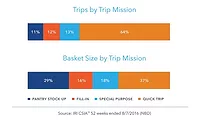Store-brand sales increase across the board
Store brands capped a decade of growth by posting sales increases across all three of the major retail channels in 2010, and pushing dollar share to new all-time highs in supermarkets, drug stores and total outlets, according to PLMA’s 2011 Private Label Yearbook. The PLMA Yearbook tracks private label sales and market share trends based on data from The Nielsen Co., Schaumburg, Ill.
Based on the latest shopper study conducted for PLMA by GfK/Roper, U.S. consumers are giving strong signs they intend to stick with store brands.
A third of those polled reported that they are buying more store brands now compared to a year ago and more than half describe themselves as frequent store brand shoppers. Half again said that they are more aware of store brands today than they were a year ago, and eight out of 10 believe that the store brand products they buy are either equal to or better than national brands.
Sales of store brands saw gains of 2 percent in U.S. supermarkets and nearly 5 percent in drug store chains, the report states. During the last decade, annual sales of private label products have increased by 40 percent in supermarkets and by 96 percent in drug stores.
In total outlets ― comprised of U.S. supermarkets, drug stores and mass merchandisers, including Wal-Mart ― store brand sales increased by nearly 2 percent while dollar share advanced by almost half a point to a new record level. Overall, sales were $88.5 billion, which is another all-time high, according to The Nielsen Co.
Store brand share of dollar sales advanced to a record 19.1 percent in supermarkets, and unit market share was 23.5 percent, according to the report. In drug stores, store brands advanced in dollar share to 14.7 percent and recorded unit share of 16.2 percent. For total outlets, store brand dollar share rose to 17.4 percent and unit share came in at 21.8 percent.
The report also notes that an estimated $15 billion to $20 billion in additional private label sales from channels that are not reporting to the Nielsen databases, such as warehouse clubs, limited assortment stores, convenience stores and dollar stores, would likely have produced a grand total exceeding $100 billion for 2010, the association states.
The spread between dollar sales performance of private label and national brands was noticeable, the report states.
In supermarkets, store brand sales increased by $1.2 billion and accounted for 100 percent of the growth in the channel, offsetting a sales drop of $149 million by national brands, according to the report’s data. The picture was much the same in drug stores, where store brand dollar sales increased by $300 million, comprising 60 percent of all incremental revenue in the channel, the report states.
Looking at total outlets, private label was up $1.5 billion while national brands were down $4.6 billion, a spread of fully $6.1 billion in sales revenue.
When it came to units sold, national brands in supermarkets gained 1 percent while store brands were essentially flat. In drug chains, private label units were off marginally and national brands were even. In total outlets, store brands gave up 0.9 percent in units and national brands lost 0.6 percent, The Nielsen Co. data reports.
Looking for a reprint of this article?
From high-res PDFs to custom plaques, order your copy today!




